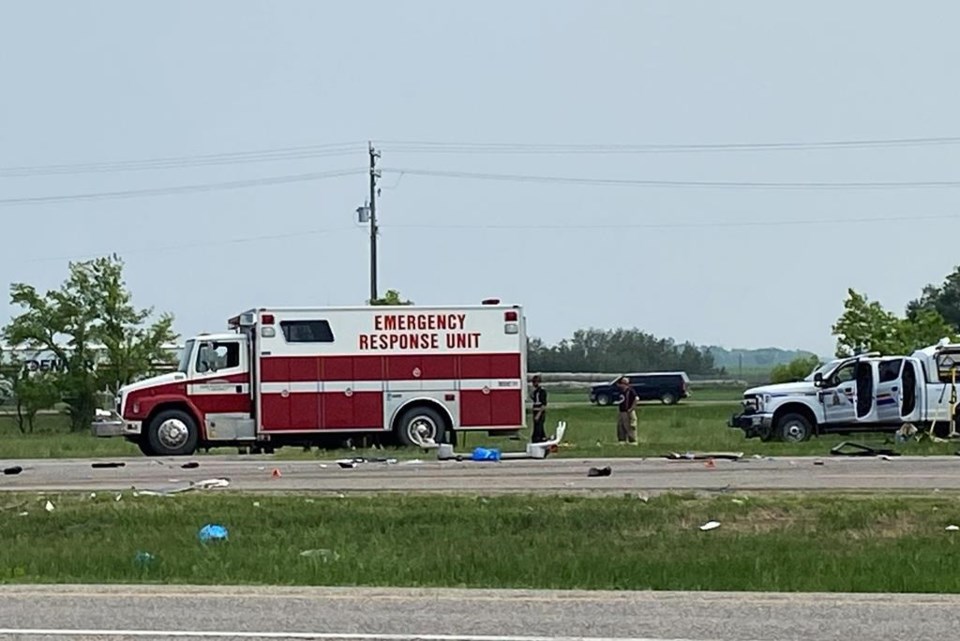DAUPHIN, Man. — The Manitoba government is promising $12 million to improve a highway intersection where a crash last year killed 17 people on a minibus on their way to a casino.
"We cannot make things right or make you whole, but we are going to work our hardest to ensure that something like this does not happen again," Premier Wab Kinew said at a news conference Monday.
Kinew, Transportation and Infrastructure Minister Lisa Naylor and government officials met with some of the victims' families and the survivors in Dauphin, Man., ahead of the release of an outside review of the intersection of Highways 1 and 5. A semi-trailer collided there with the bus carrying a group of seniors from the western Manitoba city in June.
The premier said it was a priority for his NDP government to share information with families and those affected before releasing the review.
"It was meaningful for us to have the time to engage with the families, and I thank them for their seriousness and the reverence that they are showing not only for their loved ones, but also this process of making highways safer across Manitoba."
The report said one safety risk at the intersection is a narrow median, which can be tricky for vehicles making left turns or going straight through.
It outlines three potential changes — widening the median, turning the intersection into a roundabout or restricting left turns in some directions.
Kinew said he wants to determine the safest change and follow through on it.
The review was ordered under the former Progressive Conservative government and took six months to complete. An outside consulting firm was hired to conduct a site analysis, go over video evidence and analyze data from previous collisions.
The current intersection layout generally meets transportation design standards, government officials noted, but implementing one of the three proposed changes could prevent similar collisions from happening.
The report found there were 29 collisions at the site from 2012 to 2021, with one being fatal.
The bus crash happened near the town of Carberry, about 160 kilometres west of Winnipeg.
Police said dashcam footage showed the bus was southbound on Highway 5 and crossing Highway 1 — part of the Trans-Canada Highway system — when it went into the path of the eastbound truck, which had the right of way.
The intersection consists of stop and yield signs for drivers approaching on Highway 5.
The mayor of Carberry is in favour of widening the median. Ray Muirhead said in an earlier interview that large trucks wanting to turn on or off Highway 1 cannot fit between the eastbound and westbound lanes while they wait.
"When you get semis with double trailers trying to navigate around that corner, it's treacherous."
The study looked at other potential changes, such as traffic lights and reducing the speed limit below 100 kilometres per hour, but determined those could create additional safety issues.
Smaller steps were taken in the weeks after the crash. Signage was improved, and rumble strips and pavement markings were refreshed.
The government also promised to review other parts of the province's highway network to identify potential safety concerns at other intersections.
"We are taking the lessons learned from this report and applying them to other locations across the province," said Naylor.
The RCMP is still investigating the crash. A spokesperson for the force in Manitoba said officers have yet to speak to the driver of the bus but would not elaborate due to health privacy laws.
Shared Health, the province's central health-care agency, stopped issuing updates on the injured and whether any remained in hospital.
The province said Monday that prosecutors had received the investigation file from the RCMP, but there was no word on whether charges might be laid.
Memorial sites are in the works in Dauphin and at the crash site. Kinew said the province will also help fund commemoration efforts.
"We are also going to work hard to ensure that we can be there to help you on your healing journey."
The province said there will be consultations to determine which option is the best for the intersection. The project is expected to be complete by 2026.
This report by The Canadian Press was first published Jan. 8, 2024.
— By Steve Lambert and Brittany Hobson in Winnipeg
The Canadian Press




